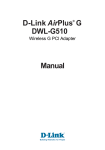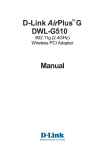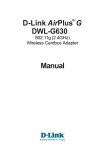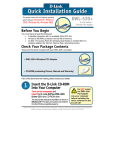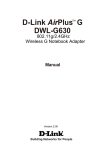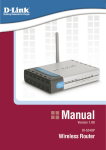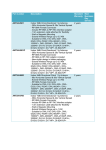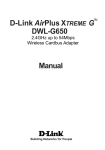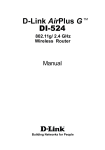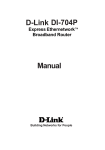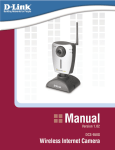Download D-Link AirPlus G DWL-G510 Specifications
Transcript
® D-Link AirPlus G DWL-G510 Wireless G Desktop Adapter Manual Version 2.00 Building Networks for People Contents Package Contents ................................................................................ 3 Introduction ............................................................................................ 4 Wireless Basics .................................................................................... 5 Installation Considerations .................................................................... 7 Getting Started ...................................................................................... 8 Using the Configuration Utility .............................................................. 11 Networking Basics .............................................................................. 20 Troubleshooting ................................................................................... 39 Technical Specifications ...................................................................... 45 2 Package Contents Contents of Package: D-Link AirPlus® G DWL-G510 802.11g (2.4GHz) Wireless G Desktop Adapter CD-ROM with Manual, Warranty, and Drivers Printed Quick Installation Guide If any of the above items are missing, please contact your reseller. System Requirements for Configuration: A desktop computer with an available 32-bit PCI slot Windows 7/VISTA/XP/2000/Me/98SE At least 32MB of memory and a 300MHz processor An 802.11g or 802.11b access point (for Infrastructure mode), or another 802.11g or 802.11b wireless adapter (for Ad-Hoc, Peer-to-Peer networking mode.) 3 Introduction The D-Link AirPlus® G DWL-G510 Wireless G Desktop Adapter is an 802.11b/802.11g (2.4GHz) wireless adapter that supports high-speed wireless networking. Unlike most network cards, the DWL-G510 provides data transfers at up to 54 Mbps (compared to the standard 11 Mbps) when used with other D-Link AirPlus® G products. The 802.11g standard is backwards compatible with 802.11b products. Features Faster Wireless Networking - Faster data transfers mean increased productivity. With the DWL-G510 in your desktop PC, you will have the flexibility of wireless networking speeds that save you time and money. Compatible with 802.11b and 802.11g Devices - Fully compatible with the IEEE 802.11b and 802.11g standards, the DWL-G510 can connect with existing 802.11bor 802.11g- compliant routers, access points and cards. That means you can still communicate with colleagues and friends while you have the ability to link to even more wireless networks. 32-bit PCI Performance/Plug & Play Connectivity - The DWL-G510 is a powerful 32-bit PCI adapter that installs quickly and easily into desktop PCs, and when used with other D-Link Air Plus® G products will automatically connect to the network out of the box. User-friendly configuration and diagnostic utilities. LED LED stands for Light-Emitting Diode. The DWL-G510 has two LEDs: Power A steady light indicates a connection to an access point. Activity A blinking light indicates activity on the network. 4 Wireless Basics D-Link wireless products are based on industry standards to provide easy-to-use and compatible high-speed wireless connectivity within your home, business or public access wireless networks. D-Link wireless products will allow you access to the data you want, when and where you want it. You will be able to enjoy the freedom that wireless networking brings. A wireless local area network (WLAN) is a computer network that transmits and receives data with radio signals instead of wires. WLANs are used increasingly in both home and office environments, and public areas such as airports, coffee shops and universities. Innovative ways to utilize WLAN technology are helping people to work and communicate more efficiently. Increased mobility and the absence of cabling and other fixed infrastructure have proven to be beneficial to many users. Wireless users can use the same applications they use on a wired network. Wireless adapter cards used on laptop and desktop systems support the same protocols as Ethernet adapter cards. People use WLAN technology for many different purposes: Mobility - Productivity increases when people have access to data in any location within the operating range of the WLAN. Management decisions based on real-time information can significantly improve worker efficiency. Low Implementation Costs - WLANs are easy to set up, manage, change and relocate. Networks that frequently change can benefit from WLANs ease of implementation. WLANs can operate in locations where installation of wiring may be impractical. Installation and Network Expansion - Installing a WLAN system can be fast and easy and can eliminate the need to pull cable through walls and ceilings. Wireless technology allows the network to go where wires cannot go - even outside the home or office. Inexpensive Solution - Wireless network devices are as competitively priced as conventional Ethernet network devices. Scalability - WLANs can be configured in a variety of ways to meet the needs of specific applications and installations. Configurations are easily changed and range from Peer-to-Peer networks suitable for a small number of users to larger Infrastructure networks to accommodate hundreds or thousands of users, depending on the number of wireless devices deployed. 5 Wireless Basics (continued) The DWL-G510 is compatible with the following wireless products: D-Link AirPlus® G DWL-G630 Wireless G Notebook Adapters used with laptop computers D-Link AirPlus® G DWL-2100AP Enhanced 2.4GHz Wireless Access Point D-Link AirPlus® G DI-524 Wireless Router The DWL-G630 is also interoperable with other 802.11g and 802.11b standardscompliant devices. Standards-Based Technology The DWL-G510 Wireless G Desktop Adapter utilizes the 802.11b and the 802.11g standards. The IEEE 802.11g standard is an extension of the 802.11b standard. It increases the data rate up to 54 Mbps within the 2.4GHz band, utilizing OFDM technology. This means that in most environments, within the specified range of this device, you will be able to transfer large files quickly or even watch a movie in MPEG format over your network without noticeable delays. This technology works by transmitting high-speed digital data over a radio wave utilizing OFDM (Orthogonal Frequency Division Multiplexing) technology. OFDM works by splitting the radio signal into multiple smaller sub-signals that are then transmitted simultaneously at different frequencies to the receiver. OFDM reduces the amount of crosstalk (interference) in signal transmissions. The D-Link DWLG510 will automatically sense the best possible connection speed to ensure the greatest speed and range possible. The DWL-G510 is backwards compatible with 802.11b devices. This means that if you have an existing 802.11b network, the devices in that network will be compatible with 802.11g devices at speeds up to 11Mbps in the 2.4GHz range. 6 Wireless Basics (continued) Installation Considerations The D-Link AirPlus® G DWL-G510 lets you access your network, using a wireless connection, from virtually anywhere within its operating range. Keep in mind, however, that the number, thickness and location of walls, ceilings, or other objects that the wireless signals must pass through, may limit the range. Typical ranges vary depending on the types of materials and background RF (radio frequency) noise in your home or business. The key to maximizing wireless range is to follow these basic guidelines: 1 Keep the number of walls and ceilings between the DWL-G510 and other network devices to a minimum - each wall or ceiling can reduce your DWL-G510’s range from 3-90 feet (1-30 meters.) Position your devices so that the number of walls or ceilings is minimized. 2 Be aware of the direct line between network devices. A wall that is 1.5 feet thick (.5 meters), at a 45-degree angle appears to be almost 3 feet (1 meter) thick. At a 2-degree angle it looks over 42 feet (14 meters) thick! Position devices so that the signal will travel straight through a wall or ceiling (instead of at an angle) for better reception. 3 Building materials can impede the wireless signal - a solid metal door or aluminum studs may have a negative effect on range. Try to position wireless devices and computers with wireless adapters so that the signal passes through drywall or open doorways and not other materials. 4 Keep your product away (at least 3-6 feet or 1-2 meters) from electrical devices or appliances that generate RF noise. 7 Getting Started There are basically two modes of networking: Infrastructure – using an access point, or wireless router, such as the DI-624. Ad-Hoc – directly connecting to another computer, for Peer-to-Peer communication, using wireless network adapters on each computer, such as two or more DWL-G510 Wireless G Desktop Adapters. On the following pages we will show you an example of an Infrastructure Network and an Ad-Hoc Network. An Infrastructure network contains an access point or a wireless router. The Infrastructure Network example shown on the following page contains the following D-Link network devices (your existing network may be comprised of other TM A wireless router - D-Link AirPlus Xtreme A laptop computer with a wireless adapter D-Link AirPlus® G DWL-G630 A desktop computer with a wireless adapter D-Link AirPlus® G DWL-G510 A cable modem - D-Link DCM-201 8 G DI-624 Getting Started (continued) Setting up a Wireless Infrastructure Network For a typical wireless setup at home (as shown above), please do the following: 1 2 4 3 DWL-G510 6 5 DWL-G630 You will need broadband Internet access (a Cable or DSL-subscriber line into your home or office). Consult with your Cable or DSL provider for proper installation of the modem. Connect the Cable or DSL modem to your broadband router. (See the Quick Installation Guide included with your router). Install the D-Link AirPlus® G DWL-G510 Wireless G Desktop Adapter into an available PCI slot on your desktop computer. (See the Quick Installation Guide included with the network adapter). Install the D-Link DWL-G630 Wireless G Notebook Adapter into a laptop computer. (See the Quick Installation Guide included with the DWL-G630). If you wish, you may connect a computer that is equipped with an Ethernet network adapter (such as a DFE-530TX+) to the router also. 9 Getting Started (continued) Setting up a Wireless Ad-Hoc Network DWL-G510 DWL-G510 Wireless G Desktop Adapter with a desktop computer Wireless G Desktop Adapter with a desktop computer Install the D-Link DWL-G510 Wireless G Desktop Adapter into one desktop computer. (See the Quick Installation Guide included with the product for installation instructions.) Install another DWL-G510 into a desktop computer. (See the Quick Installation Guide included with the product.) Set the wireless configuration for the adapters to Ad-Hoc mode, set the adapters to the same channel, and assign an IP address to each computer on the Ad-Hoc network. (See the box below). IP Address When assigning IP addresses to the computers on the network, please remember that the IP address for each computer must be in the same IP address range as all the computers in the network, and the subnet mask must be exactly the same for all the computers in the network. For example: If the first computer is assigned an IP address of 192.168.0.2 with a subnet mask of 255.255.255.0, then the second computer can be assigned an IP address of 192.168.0.3 with a subnet mask of 255.255.255.0, etc. IMPORTANT: If computers or other devices are assigned the same IP address, one or more of the devices may not be visible on the network. 10 Using theConfigurationUtility D-Link AirPlus® G DWL-G510 uses the Configuration Utility as the management software. The utility provides the user an easy interface to change any settings related to the wireless adapter. After you have completed the installation of the DWL-G510 (refer to the Quick Installation Guide that came with your purchase) whenever you start the computer, the Configuration Utility starts automatically and the system tray icon is loaded in the toolbar (see illustration below*.) Clicking on the utility icon will start the Configuration Utility. Another way to start the Configuration Utility is to click on Start>Programs>D-Link AirPlus® G >D-Link AirPlus® G Utility. If you are using Windows XP, you can use either the Zero Configuration Utility or the D-Link Configuration Utility. To use the D-Link Configuration Utility with XP, right-click on the wireless network icon in the taskbar in the lower right-hand corner of your computer screen. In the window that appears, select View Available Wireless Networks and click the Advanced button. The screen at right will appear. Select the Wireless Networks tab. Uncheck the box in the properties window that enables windows configuration. After you have done this, you can then use the D-Link Configuration Utility with XP by clicking on the D-Link Configuration Utility icon. If the icon does not display in the taskbar, then click on this icon on your desktop to open. 11 *Configuration Utility icon in the system tray Configuration Utility (continued) If you are using Windows 7 and VISTA, you will need to use the Zero Configuration Utility. Using Windows® 7 If you receive the Wireless Networks Detected bubble, click on the center of the bubble to access the utility. or Left-click the wireless icon in your system tray (lower-right corner next to the time). The utility will display any available wireless networks in your area. Click on a network (displayed using the SSID) and click the Connect button. If you get a good signal but cannot access the Internet, check your TCP/IP settings for your wireless adapter. Refer to the Networking Basics section in this manual for more information. 12 Configuration Utility (continued) Using Windows® Vista™ If you receive the Wireless Networks Detected bubble, click on the center of the bubble to access the utility. or Right-click on the wireless computer icon in your system tray (lower-right corner next to the time). Select Connect to a network. The utility will display any available wireless networks in your area. Click on a network (displayed using the SSID) and click the Connect button. If you get a good signal but cannot access the Internet, check you TCP/IP settings for your wireless adapter. Refer to the Networking Basics section in this manual for more information. Enter the same security key or passphrase that is on your router and click Connect. It may take 20-30 seconds to connect to the wireless network. If the connection fails, please verify that the security settings are correct. The key or passphrase must be exactly the same as on the wireless router. 13 Configuration Utility (continued) Link Info Status: Displays the MAC Address of the Access Point that is associated with the DWL-G510. SSID: Displays the Service Set Identifier assigned to the wireless network. Frequency: Displays the current frequency used by the adapter. Wireless Mode: Displays the wireless mode. The default is Infrastructure. Encryption: Displays whether Encryption is enabled or disabled. Connection Info: Indicates if the adapter is connected to the network. TxRate: Displays the current data transmission rate. Channel: Displays the channel information. By default, the channel is set to 6 and selection is automatically determined by the DWL-G510. Signal Quality: The percentage coincides with the graphical bar. Signal Strength: Represents the wireless signal between the access point and the DWL-G510. Packet Count: Graphically displays the statistics of data transmitted and received. 14 Configuration Utility (continued) Configuration SSID: The Service Set Identifier is the name assigned to the wireless network. The factory SSID setting is set to default. Make changes here to match the SSID on existing Wireless Router or Access Point. Wireless Mode: Click on the pull-down menu; select from the following options: Infrastructure - Connecting to the WLAN using an access point. (This is the default setting.) Ad-Hoc - Wireless mode used when connecting directly to a computer equipped with a wireless adapter in a Peer-to-Peer environment. Data Encryption: The default setting is set to Disabled. The adapter supports WEP and WPA/WPA2 when encryption is enabled. Authentication: Allows you to specify the authentication mode for the network. The default setting is set to Open Authentication. Key Length: When encryption is enabled, you will have the option to specify the level and key format of the encryption used. Select the appropriate Key Index: 1-4 and enter ASCII or hexadecimal digits in the appropriate field. IEEE 802.1x: When encryption is enabled, you will have the option to specify if you wish to use 802.1x authentication. Click Apply to save the changes. 15 Configuration Utility (continued) Advanced r Frequency: Select 802.11b/g for compatibility with both 802.11b or 802.11g networks, or select 802.11b only. Ad Hoc Channel: Select the Ad Hoc channel when in Ad Hoc mode. When communicating in Ad Hoc mode, all devices must share the same channel. Profile IP Settings: You can Enable or Disable the IP Settings portion of your profile here. If you select Disable you will need to configure the IP address information each time you connect to a network. If you select Enable, you will maintain the same IP address information each time you connect to a network. Power Mode: Disable - This default setting consumes the most power. Enable - This setting consumes the least power. Launch Utility on Start Up: Select Enable or Disable. Click Apply to save the changes. 16 Configuration Utility (continued) Site Survey Available Networks The top section of the window displays the Available Networks. Scroll up and down the list and highlight the network to which you wish to connect. Click on the Connect button. Profile In the lower half of the screen, you can manage the profiles that you have created for the wireless network at home, at the office and in public places. Scroll up and down and highlight the profile that you wish to configure. You can Add or Remove a profile, or configure the Properties of the profile in order to connect with an available network. Add, Connect and Properties Click on Add, Connect, or Properties and the screen on the next page will appear. 17 Configuration Utility (continued) Site Survey > Add, Connect, or Properties In this window you can configure all the properties of a profile in order to connect with a network of your choice. After you have entered your changes in this window, click OK to save the changes. 18 Configuration Utility (continued) About The About screen gives you information about the Firmware and Utility Versions of the DWL-G510. 19 Networking Basics Using the Network Setup Wizard in Windows XP In this section you will learn how to establish a network at home or work, using Microsoft Windows XP. Note: Please refer to websites such as http://www.homenethelp.com and http://www.microsoft.com/windows2000 for information about networking computers using Windows 2000/Me /98SE. Go to Start>Control Panel>Network Connections. Select Set up a home or small office network. When this screen appears, click Next. 20 Networking Basics (continued) Please follow all the instructions in this window: Click Next. In the following window, select the best description of your computer. If your computer connects to the Internet through a router, select the second option as shown. Click Next. 21 Networking Basics (continued) Enter a Computer description and a Computer name (optional.) Click Next. Enter a Workgroup name. All computers on your network should have the same Workgroup name. Click Next. 22 Networking Basics (continued) Please wait while the Network Setup Wizard applies the changes. When the changes are complete, click Next. Please wait while the Network Setup Wizard configures the computer. This may take a few minutes. 23 Networking Basics (continued) In the window below, select the option that fits your needs. In this example, Create a Network Setup Disk has been selected. You will run this disk on each of the computers on your network. Click Next. Insert a disk into the Floppy Disk Drive, in this case drive A. Click Next. 24 Networking Basics (continued) Please read the information under Here’s how in the screen below. After you complete the Network Setup Wizard you will use the Network Setup Disk to run the Network Setup Wizard once on each of the computers on your network. To continue, click Next. 25 Networking Basics (continued) Please read the information on this screen, then click Finish to complete the Network Setup Wizard. The new settings will take effect when you restart the computer. Click Yes to restart the computer. You have completed configuring this computer. Next, you will need to run the Network Setup Disk on all the other computers on your network. After running the Network Setup Disk on all your computers, your new wireless network will be ready 26 Networking Basics (continued) Naming your Computer To name your computer in Windows XP, please follow these directions: Click Start (in the lower left corner of the screen). Right-click on My Computer. Select Properties. Select the Computer Name Tab in the System Properties window. You may enter a Computer Description if you wish; this field is optional. To rename the computer and join a domain, click Change. 27 Networking Basics (continued) Naming your Computer In this window, enter the Computer name. Select Workgroup and enter the name of the Workgroup. All computers on your network must have the same Workgroup name. Click OK. 28 29 30 Networking Basics (continued) Checking the IP Address in Windows XP This window will appear. Click the Support tab. Click Close. 31 32 Networking Basics (continued) Assigning a Static IP Address Note: Many broadband routers will automatically assign IP addresses to the computers on the network, using DHCP (Dynamic Host Configuration Protocol) technology. If you are using a DHCP-capable router you will not need to assign static IP addresses. If you are not using a DHCP capable router, or you need to assign a static IP address, please follow these instructions: In Windows XP/ 2000 Go to Start. Click on Control Panel. Double-click on Network Connections. 33 34 35 36 37 38 Troubleshooting This chapter provides solutions to problems that can occur during the installation and operation of the DWL-G510. Read the following descriptions if you are having problems. (The examples below are illustrated in Windows XP. If you do not use Windows XP, the screens on your computer will still look similar to the following examples.) 1. How do I check that the drivers for the DWL-G510 are installed properly? In Windwos XP/2000 Go to Start > My Computer > Properties. Select the Hardware Tab. Click Device Manager. 39 Troubleshooting (continued) Double-click On Network Adapters. Right-click on D-Link DWL-G510 Wireless PCI Adapter. Select Properties to check that the drivers are installed properly. Look under Device status to check that the device is working properly. Click OK. 40 Troubleshooting (continued) 41 Troubleshooting (continued) Double-click On Network Adapters. Right-click on D-Link DWL-G510 Wireless PCI Adapter. Select Properties to check that the drivers are installed properly. Look under Device status to check that the device is working properly. Click OK. 42 Troubleshooting (continued) 2. Why can’t I connect to the access point or the wireless router? Make sure that the SSID on the DWL-G510 Wireless G Desktop Adapter is exactly the same as the SSID on the access point or wireless router. Move the DWL-G510 and the access point or wireless router into the same room and then test the wireless connection. Disable all security settings. (WEP, MAC address control, AES). Make sure that the access point/router is not set to a different frequency. Turn off your access point and the computer with the DWL-G510. Turn on the access point, and then turn on the computer with the DWL-G510. Refresh the DWL-G510 Utility. 3. Why aren’t the Power and Link lights on? Check to see if the DWL-G510 Wireless G Desktop Adapter is firmly inserted into the PCI slot of your laptop computer. 4. I forgot my Encryption key. What should I do? Reset the access point to its factory default settings and restore the DWLG510 Wireless G Desktop Adapter to the factory default settings. 5. What should I do when the computer does not recognize the DWL-G510 Wireless G Desktop Adapter? Make sure that the DWL-G510 Wireless G Desktop Adapter is properly seated in the computer’s PCI slot. If Windows does not detect the hardware upon insertion of the adapter, make sure to completely remove drivers that were previously loaded. To remove the drivers, do the following: 43 Troubleshooting (continued) A. Under Tools> select Folder Options…> select View > under Hidden files and folders > select Show hidden files and folders. B. Uncheck Hide extension for known file types > click on Apply. C. Search for previously loaded driver files. Remove these files from the INF and SYSTEM32 (DRIVERS) folders in the Windows directory. Note: Windows XP and Windows 2000 will rename .inf files that have not received WHQL certification into oem.inf files (e.g., oem1.inf.) 6. What should I do when the computer with the DWL-G510 installed is unable to connect to the wireless network and/or the Internet? Check that the LED indicators for the broadband modem are indicating normal activity. If not, there may be a problem with the broadband connection. Check that the LED indicators on the wireless router are functioning properly. If not, check that the AC power and Ethernet cables are firmly connected. Check that the IP address, subnet mask, gateway, and DNS settings are correctly entered for the network. In Infrastructure mode, make sure the same Service Set Identifier (SSID) is specified on the settings for the wireless clients and access points. The SSID factory default setting for most D-Link products is default. (Doubleclick on the WLAN icon in the taskbar. The Link Info screen will display the SSID setting.) In Ad-Hoc mode, both wireless clients will need to have the same SSID. Please note that it might be necessary to set up one client to establish a BSS (Basic Service Set) and wait briefly before setting up other clients. This prevents several clients from trying to establish a BSS at the same time, which can result in multiple singular BSSs being established, rather than a single BSS with multiple clients associated to it. 44 Technical Specifications Standards IEEE 802.11g IEEE 802.11b Temperature Operating: 0ºC to 55ºC (32ºF to 131ºF) torage: -20ºC to 65ºC (-4ºF to 149ºF) Humidity: 5%-95% maximum, non-condensing Antenna Type: Built-in diversity patch antenna, 2dBi gain (max.) PCI Standard: PCI 2.2 Security: 64-,128-bit WEP Encryption Physical Dimensions: L = 4.72 inches (120 mm) W = 2.52 inches (64 mm) H = 0.24 inches (6 mm) Weight: 0.12 lb. (55 grams) 45 Technical Specifications (continued) Data Modulation Type: DBPSK, DQPSK, CCK and OFDM (BPSK/QPSK/16-QAM/64-QAM) Power: 3.3 Volt ± 5% Power Consumption: 802.11g: TX 550mA, RX 330mA, Standby 300mA 802.11b: TX 580mA, RX 350mA, Standby 300mA Channels: 1-11 channels (North America) Regulation Compliant: Wireless: Wi-Fi US: FCC part 15 class B, Sec. 15.247, 15.109 Sensitivity for 802.11b: 11Mbps (CCK): -84dBm 5.5Mbps (CCK): -86dBm 2Mbps (DQPSK): -88dBm 1Mbps (DBPSK): -89dBm typically @PER <8% packet size 1024 and @25° Sensitivity for 802.11g: 54Mbps (OFDM): -69dbm 48Mbps (OFDM): -70dbm 36Mbps (OFDM): -74dbm 24Mbps (OFDM): -77dbm 12Mbps (OFDM): -83dbm 6Mbps (OFDM): -85dbm typically @PER <8% packet size 1024 and @25° Configuration: Plug & Play setup and installation Network: Auto-switch to use 802.11g or 802.11b mode 46 Technical Specifications (continued) Data Rates: With Automatic Fallback 54Mbps; 48Mbps; 36Mbps; 24Mbps; 18Mbps; 12Mbps; 11Mbps; 9Mbps; 6Mbps; 5.5Mbps; 2Mbps; 1Mbps Frequency Range: 2.4GHz to 2.462GHz Range:* Indoors: Up to 328 feet (100 meters) Modulation Technology: Orthogonal Frequency Division Multiplexing (OFDM) Transmitter Output Power: 15dBm ± 2dB *Environmental factors may adversely affect range. 47















































